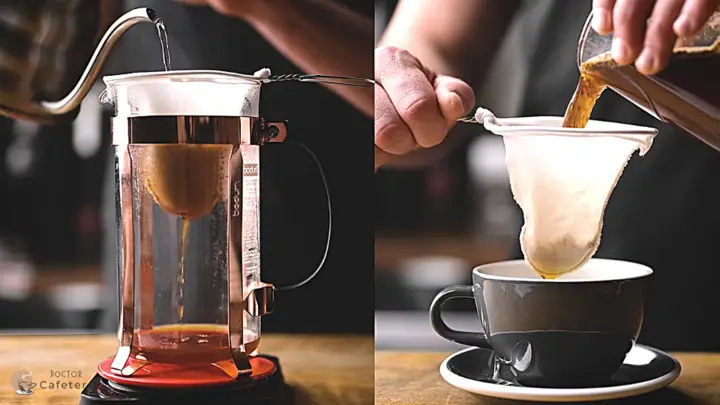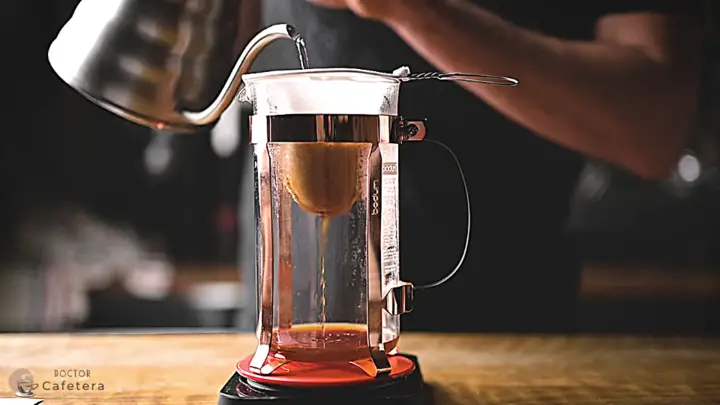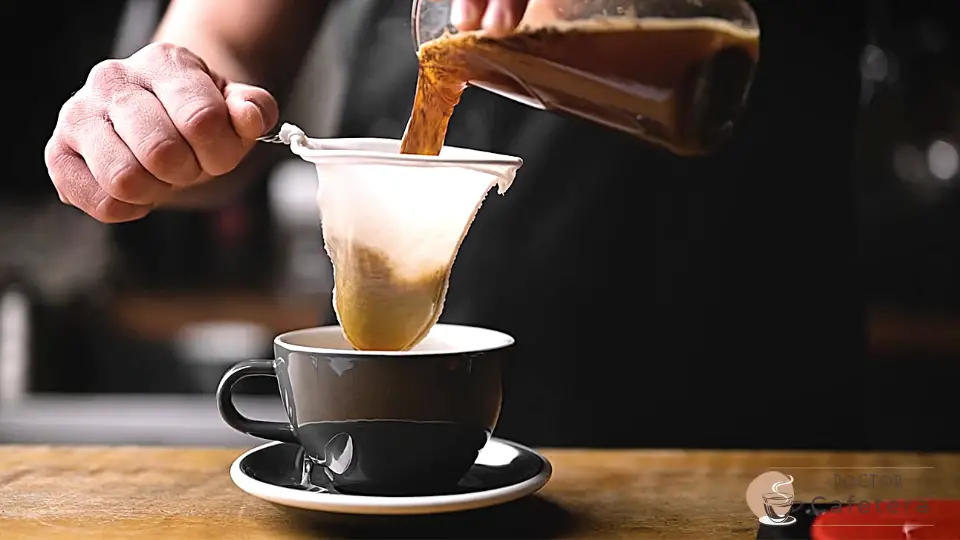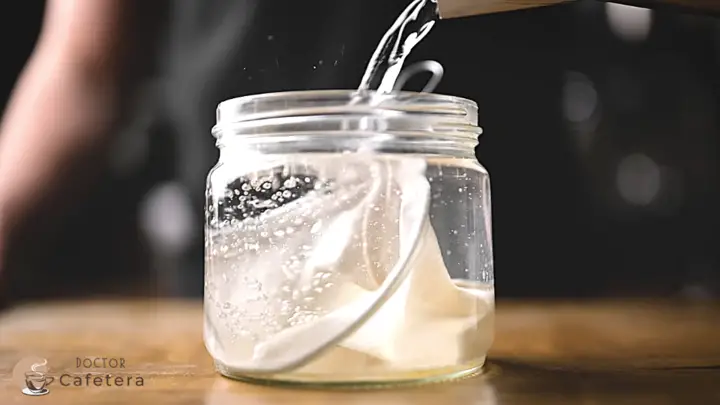The cloth filter is the oldest coffee filtering method in the world; it emerged at the end of the 17th century and was, for a long time, the only way to prepare coffee. Depending on how old you are, you probably had (or have) one of these at home.
Depending on the country from where you are reading this article, you may know it as a cloth filter, fabric filter, cloth strainer, fabric strainer, cloth dripper, or “chorreador”.
This coffee filter consists of a cloth sleeve, usually made of cotton. The cover is supported by a metal ring, which takes the shape like a stocking or sock when brewing coffee. In this article, we will see the drip and immersion methods.
It is one of the simplest and most economical ways to prepare coffee at home; besides being environmentally friendly if used correctly, it produces a great flavor and an incredible texture.
Preparing coffee in a sustainable way
Many readers have asked me what the most sustainable coffee brewing method is, and my answer is always the same; brew coffee without a coffee maker and use a cloth filter.
Most of the coffee makers we use require energy and plastic materials to be manufactured. Many require electricity, and some produce a lot of waste, as with coffee pod machines.
Even sustainable manual pour-over coffee makers, such as the Kalita Wave, Chemex, and Hario V60, use paper filters that cause CO2 emissions during manufacture and contribute to deforestation.
By using a cloth filter, we can reduce the amount of waste and deforestation. On the other hand, they provide an economic benefit, as they are cheap and reusable.
Note: The cleaning will be a great disadvantage of the coffee cloth filters; to guarantee a good flavor, it must always be clean and not with a brown color coming from the coffee.
Preparation of drip coffee using a cloth filter. My ideal recipe
If you have a new cloth filter, you first need to soak it for a few minutes in boiling water to clean and disinfect it.
It would be best to have support to hold the filter up, so it doesn’t touch the extracted coffee. I like to use the French press carafe, but if you can’t find a container that works for you, you can hold it by hand.
Before inserting it, leave the filter seam facing outwards; this will favor the filtration and make the cleaning much easier.
This is my ideal recipe for the drip method:
- Coffee beans: 15 grams (approximately one and a half tablespoons).
- Type of grind: Medium (intermediate texture between sugar and sand).
- Filtered water: 250 grams.
- Water temperature: 92 ºC
Preparation of drip coffee using a cloth filter. Step by step
The steps I describe below are based on my experience and may vary or be adjusted according to the tastes of the person preparing the coffee. However, I am guaranteed great results every time I perform this procedure meticulously.
- Before placing the ground coffee in the cloth filter, we will pass some hot water to rinse and preheat.
- We discard the water that comes out from rinsing the cloth filter.
- Add 15 grams of coffee. Same amount as the siphon method.
- We start the timer and add 250 milliliters of water until the ground coffee is covered.
- Lift the filter and give it a few turns to ensure all the coffee’s parts are well-soaked.
- When the time reaches 45 seconds, we will add the rest of the water slowly. When we have poured the 250 grams of water, we lift the filter again and give it a few turns (this will help us to obtain an even extraction).
- Now let it drain, taking approximately 2 minutes.
If you are used to paper filters, you will notice that it drains a little faster since the holes in the filter are a little larger and allow more coffee to pass through.
Preparation of immersion coffee with a cloth filter. My ideal recipe
The other alternative for preparing coffee with a cloth filter is immersion. This is, perhaps, the most common and traditional in our coffee worldwide.
It is also called boiled coffee, where it is infused with water in a pot and then passed through the cloth filter.
- Coffee beans: 15 grams (approximately one and a half tablespoons).
- Type of grinding: Medium/coarse (texture similar to breadcrumbs or coarse sand).
- Filtered water: 250 grams.
- Water temperature: boiling*.
*The coffee is added to the boiling water, but not over the fire; we do not want to boil the coffee.
Preparation of the coffee with the cloth filter by immersion. Step by step
This is one of the simplest recipes to prepare coffee and will remind you of the one we used to use in the French press.
- Use a container to mix the water with the coffee.
- Place one and a half tablespoons of coffee.
- Start the timer and add 250 milliliters of boiled water. Add the water quickly and wet all parts of the coffee.
- Let it infuse for 4 minutes.
- A few seconds before the 4 minutes are up, pass some hot water through the filter and over the cup where we will drink and discard the coffee.
- When the 4 minutes are up, we use the filter as a strainer. Having a medium/coarse grind, the coffee will take a few seconds to drain.
Cleaning and maintenance of the cloth filter
When we finish filtering, we must remove the ground beans first and then take the filter to the sink to wash it with hot water and without soap. I recommend that you do this immediately after brewing the coffee so that the oils come off more easily.
Then, the best way to keep it clean is to keep it soaked in a jar or container in the refrigerator. When you use it, throw away the water and run some hot water through it to remove any taste.
After several uses, when the filter is staining the color of coffee, you can soak it in boiling water and a few teaspoons of baking soda for about 10 minutes. In this way, we will do a deep cleaning. Then, rinse it well with hot water, and it will be ready to use or stored in the refrigerator for its next use.
What does cloth filter coffee taste like?
The cloth filter method offers us a “filtered coffee”, but the question is, are there differences between paper and metal filters? Yes, the body or texture of a coffee will be strongly linked to the filtration method.
- The paper filter has very small holes, which retain the small particles and oils in the coffee, leaving it almost crystalline. The flavors’ result is clarity and brightness, highlighting the notes with little body.
- The metal filter has larger holes, which do not allow the ground coffee to pass through, but the oils and small particles do. This gives more body and weight to the coffee and more texture but not so much brightness and clarity in the flavor.
- The cloth filter is located right in the middle of the previous ones. A very silky texture is obtained because more oils pass through it. But at the same time, it retains more than the metal filter, so it is cleaner, has more noticeable flavors, and maintains a pronounced body.
Are there cloth filters for the Chemex or the Hario V60?
Suppose you are familiar with manual pour-over filtering methods. In that case, you will know that paper filters play an important role in coffee brewing, so much so that some contribute a particular flavor to the final beverage. But in case you didn’t know, there are cloth filters for the Chemex or the Hario V60.
Paper filters stand out for their capacity to retain many coffee particles. For example, the Chemex filters, one of the thickest filters available (folds in four parts), produce a coffee with great clarity in its flavors and a super clean cup.
The Chemex cloth filter also folds into four parts, but what’s the difference?
- Extraction time is significantly reduced with the cloth filter, as the thickness of the paper puts up more resistance to the passage of water.
- In terms of flavor, a coffee with more acidity is obtained, which, together with a creamier body, results in a very balanced coffee.
Depending on the coffee used, the results change, and it is very interesting to see that choosing the filtration method can enrich the experience.
You may be interested in the following:



